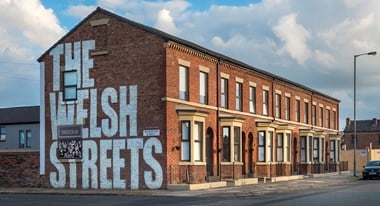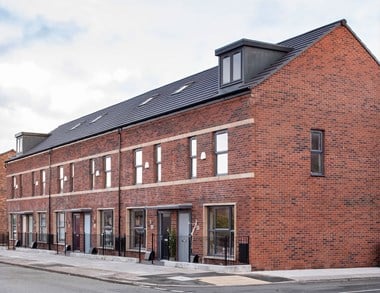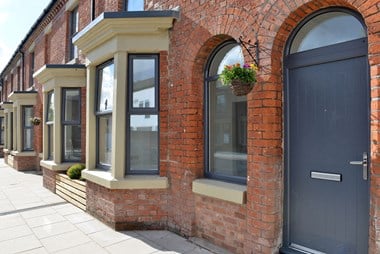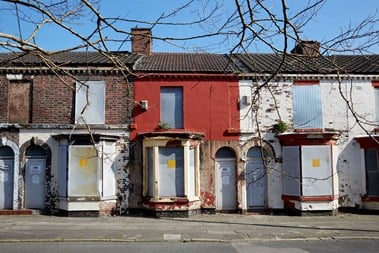Design Case Study: Welsh Streets Liverpool 8
An ambitious and popular scheme that converts hundreds of derelict Victorian terraced houses and mends the urban fabric with sympathetically designed infill development.
This case study is one of ten studies of new residential or mixed-use developments compiled in 2020 by Purcell on behalf of Historic England.
Project information
- Region: North West
- Type of development: Urban infill and regeneration site
- Location and postcode: Liverpool L8
- Local planning authority: Liverpool City Council
- Architects: MCAU
- Developer / land owner: Placefirst
- Number of residential units: TBC
- Other uses: N/A
- Awards: Outright Winner of the Sunday Times Homes Awards 2018 for the Best Housing Project in the UK; The Building Awards 2018 Refurbishment Winner
Description of development
The Welsh Streets comprise a block of terraced Victorian streets in inner-city Liverpool. Seven parallel streets run from High Park Street to the north-west to South Street to the south-east. These are Wynnstay Street, Voelas Street, Rhiwlas Street, Powis Street, Madryn Street, Kinmel Street and Gwydir Street. Two further streets (Pengwern Street and Treborth Street) run from Admiral Street to the south-west to Gwydir Street. The area is bordered by Kelvin Grove to the north-east. These streets are mainly residential with some scattered commercial uses along High Park Street. The original houses are of two storeys, with some larger three-storey terraces along Kelvin Grove.
The Welsh Streets were the subject of a protracted planning battle to determine their future, culminating in a public inquiry in 2014. At that time there were around 400 empty Victorian terraced houses. The scheme which was subsequently approved is being delivered over six development phases. It involves the retention of almost all the surviving houses in the area. This has been achieved through comprehensive remodelling of the existing houses combined with new-build houses which occupy gaps in the street frontages. Adjacent properties have been knocked through to create a mix of family homes that are for affordable private rent, and where all residents have access to landscaped communal gardens. The later phases of new housing are contemporary in their design, whilst respecting the heritage and character of the existing and remodelled terraces.
Heritage assets affected
The site comprises seven streets of Victorian terraced houses, designed by architect Richard Owens, and laid out in the 1870s. They lie immediately to the north-west of the Princes Park Conservation Area and are close to Princes Park itself, though visually separated from it behind grand villas that line Devonshire Road. The houses in the Welsh Streets are neither listed nor within a designated conservation area, however they are recognised as non-designated heritage assets. The Secretary of State, in determining an application to demolish the majority of the houses, considered that the surviving built and cultural heritage in the Welsh Streets is of considerable significance. The survival of Ringo Starr’s birthplace at No.9 Madryn Street gives the area added cultural significance as part of Liverpool’s Beatles heritage.
Planning context
The Welsh Streets were earmarked for clearance under the Housing Market Renewal policy, also known as the Pathfinder programme, which operated between 2002 and 2011. The demolition of the area had not commenced when the programme was cancelled in 2011, however most of the houses were left empty. Plans to demolish the majority of the houses were again proposed in 2013. SAVE Britain’s Heritage mounted a vigorous campaign to protect the Welsh Streets from demolition. The scheme was the subject of a public planning inquiry in 2014. The Inspector was minded to approve the scheme. However the decision was called in by the Secretary of State who overturned their Inspector’s decision and refused permission. The reasons for the decision are contained in a letter from the MHCLG of January 2015.
The current development has been the subject of a number of planning approvals granted between 2017 and 2019. The refurbishment, partial demolition, conversion and rebuilding of houses in the Welsh Streets was the subject of a series of four planning applications that were granted permission by the City Council in 2017 and 2018 (planning refs. 17H/0818, 17H/1812, 18F/0012 &18F/2803). A further permission was granted in 2019 which covers the erection of 52 new dwellings on land at Wynnstay Street, Voelas Street, Rhiwlas Street and South Street (planning ref. 19F/0112).
Assessment of design qualities and relationship to historic environment
The developer, Placefirst, along with Plus Dane Housing and the City Council have been working towards regenerating the Welsh Streets through an extensive programme of refurbishing the existing terraced housing stock where possible. The new-build element consists of 52 new dwellings which re-instate the original terraced form on land where the former dwellings had been demolished. Two thirds of the land was formerly designated as a neighbourhood park, located to the rear of derelict dwellings that had been in a very poor condition in excess of ten years. However this land did not provide a safe or attractive amenity.
There are two main elements to the design – one which entails the use of a contemporary twist on the terraced form using a ‘saw tooth’ approach where the existing terraces are to be continued, or infilled, and the other using a much more contemporary approach to the development facing South Street.
The designs were altered during the course of the application to ensure that eaves and window heights line through with the original terraces. Although somewhat controversial, the use of the ‘saw tooth’ roof form was considered by the City’s planning officer to be appropriate. The facing materials pick up on the colour and type of the original terraces. The proposed new dwellings therefore re-emphasise the terraced character of the Welsh Streets area.
The design of the end-of-terrace units that front onto South Street was amended in the course of negotiations with City planners. The result has been revised house types that include pitched roofs and fewer flat-roofed elements. The use of a modern contemporary approach on these end units signals the end of the terraces with a more dynamic form that creates visual interest and helps to re-animate South Street.
Key points
The City Council played a crucial role in transferring the empty and derelict houses to a residential private rental company – Placefirst – for a nominal sum which ensured that the scheme was made viable. Local opinion, which had been divided during the protracted planning battle over the area’s future, is now fully supportive of the development; this is attracting former residents to return and has been recognised as one of the ‘coolest’ areas to live in the city and where a new ‘Welsh Streets’ community, which the area was historically renowned for, is starting to once again re-establish itself.
The re-configuration of the original houses, including the removal of rear extensions and provision of communal spaces at the rear of the terraces, encourages community and creates space for family living. Negotiations with the City planners led to design changes which improved the relationship of the new housing to surrounding streets.
The scheme provides a blueprint for developers and local authorities whereby the typical outdated ‘two up two down’ terrace houses have been reconfigured to deliver a more varied mix of two, three and four-bedroomed homes, more suited to modern-day family living and market demand. The result is attractive homes that have retained their historic nature characterised by attractive brickwork detailing, large window openings, and high floor-to-ceiling heights, and an array of homes that are also larger than the MHCLG’s current space standards for housing which are applied by the majority of volume housebuilders.
Views of the Welsh Streets, Liverpool 8
Please click on the gallery images to enlarge.
-
Design in the Historic Environment
Principles and case studies for good practice in design when making changes to the built historic environment.
-
Design in the Historic Environment: Case Studies
Download all ten case studies as a PDF document.
-
Design Case Study: Roussillon Park Chichester, West Sussex
A case study of design in the historic environment: Roussillion Park is a modern residential complex at the site of a former barracks in Chichester.
-
Wildernesse House Mews, Sevenoaks
Case study of a new mews-style development within the setting of a Grade II listed mansion and within an area of historic landscape.
-
Bourne Estate, Holborn, London
An award-winning residential extension on a Grade II listed urban estate, bringing together old and new through quality detailing and landscaping.
-
Design Case Study: 168 Upper Street, Islington
A case study of an imaginative reinstatement of a missing corner building in Islington that reproduces the original facade.
-
Temple Gardens, Temple Cloud
Design case study of the refurbishment and viable reuse of a listed pub, with a sensitive scheme of new housing and hotel development.
-
Fairmile Hospital
Case study of the re-development of a former hospital on the edge of a rural village with new homes designed as distinctive groups.
-
Garden Quarter, Caversfield
Case study for design in the historic environment of the sensitive redevelopment of a former Royal Air force site into a residential community.
-
Church Fields, Boston Spa
A design case study featuring a residential extension to the edge of an historic village that interprets traditional architectural forms.
-
Timekeepers Square, Salford
Case study of a redevelopment that recreates the vernacular Georgian terrace and urban grain within the setting of a listed church.










